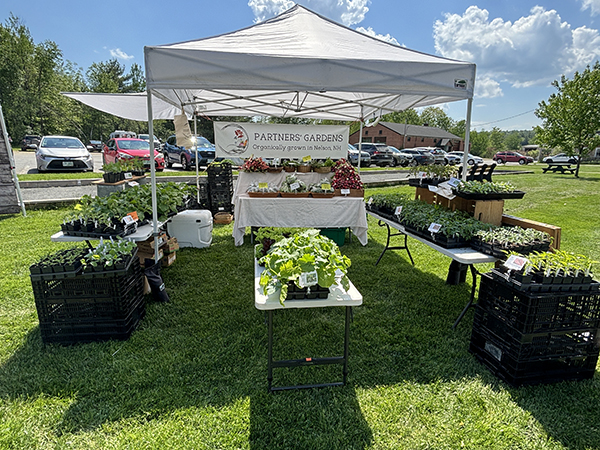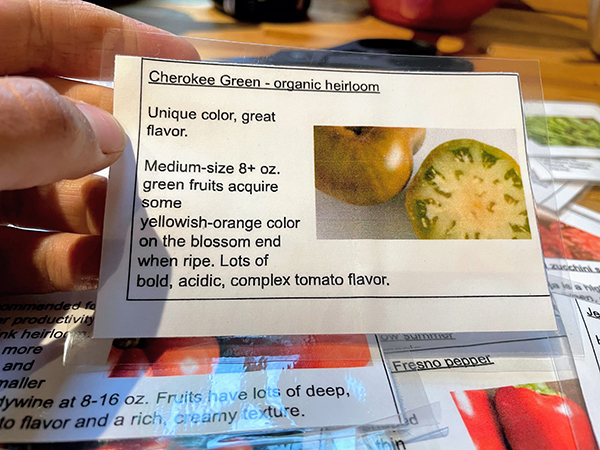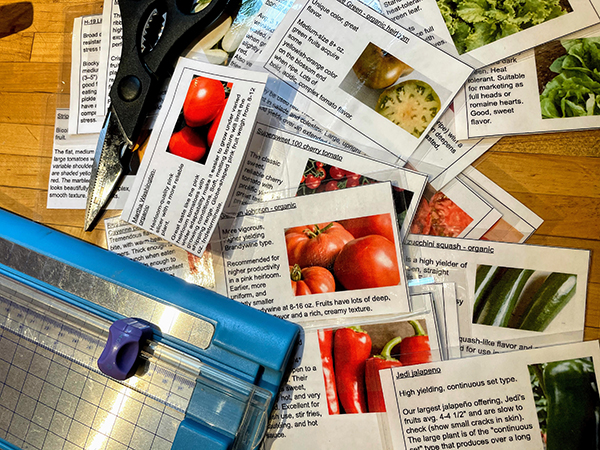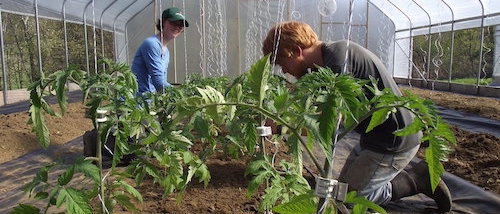I farm in rural New Hampshire where most of our friends and neighbors have impressive gardens. While I’d love to say that everyone in a 10-mile radius flocks to our farmers market table and farm stand, these individuals don’t need our fresh produce, our main product line. So, how could we create demand for a product they do need?
Enter garden starts. Since adding these to our offerings, our customer base has grown each season. When we shifted our mindset, pivoted, and created demand for a new, locally produced product, we gained avid local gardeners as customers. In addition to fresh produce, we spend the early spring months focusing on growing the healthiest garden seedlings possible that people can bring home to their gardens.

An early spring farmers market set-up, heavy on the garden starts. All photos courtesy of the author.
Hosting an annual plant sale helps us boost early-season income, connect with our community members, and kick off the season at the farm. I’ll discuss what types of farmers this option works best for, what crops to focus on for maximum profits, and methods we’ve found successful in this endeavor.
Growing starts fits these farms well
Adding garden starts to your spring line-up is perfect for small farms looking for additional income, serious homesteaders with space to start seeds, and short-season farms looking to boost revenue in the shoulder months. It’s also perfect for non-CSA farms that need early-season cash flow. Additionally, if you’re like us and focus on growing just a few crops, starting seedlings of crops you don’t grow to maturity is a way to keep things fun and exciting.
Over the past few years, we’ve developed a following for our annual plant sale. We expand it each year and make it more of an event to signify coming out of the long, cold winter and transitioning into spring gardening. For some neighbors, this is an exciting gathering they look forward to. We have hosted the event on the second Saturday of May for several years so people can mark their calendars and plan their garden prep accordingly.
We offer local coffee, donuts, and live music, encouraging people to peek into the high tunnels and look around. It’s the perfect opportunity to showcase the new infrastructure we’ve installed, our growing crops, and newly opened fields. It feels like a party, and we always look forward to it because it allows us to connect with our community before the season’s craziness begins.

Garden starts hardening off before our annual plant sale in 2022. The pink flags help us identify varieties and make for easy shopping.
We’ve decided to expand this year’s sale to several weekends at the farm and a pop-up farmers market in a new town. We also hope to sell the products at our local nursery and events.
Crops to focus on
We’ve tried many crops over the years, but the ones I’ve listed below are our tried-and-true. Demand will differ regionally, so take that into account when making selections. For instance, okra and collard greens may sell better in southern states, where those vegetables are frequently used in popular dishes. In contrast, we have found that people in the Northeast don’t gravitate toward extra-spicy peppers but love good storage squash.
Summer Vegetables: No garden is complete without what I call the heavy hitters, which we sell as singles. Tomatoes are in 4.5-inch pots; everything else goes in a 2-inch pot unless otherwise noted. Tomatoes are hands-down our most significant money-making plant start. It’s easy to upsell customers on a new type or variety. I promise you, no one is there to buy one tomato.
Tomatoes: We typically grow three reliable heirlooms, two types of red slicers, three to four cherries, and one paste tomato. I like to trial one or two new varieties each season.
Cucumbers: We grow one slicer and one to two pickling varieties, typically ‘Marketmore’ and ‘Cool Customer,’ because they are reliable and the seeds are affordable.
Summer squash and zucchini: Pick one reliable and productive variety of each. Home gardeners often prefer semi-spineless or spineless.
Head lettuce: I typically mix varieties; each four-pack contains reds and greens. Butterhead, romaine, red leaf, and summer crisps are reliable and popular.
Eggplant: One globe and one slender Asian variety.
Peppers: One sweet Italian or bell and jalapeños.
Watermelon: We love the cooler-box type ‘Sugar Baby’ because it’s excellent for small-space growers and has an unmatched flavor.
Herbs: Genovese basil, flat parsley, common sage, cilantro. We sell parsley and sage in two-inch pot singles, and basil and cilantro in four-packs.
Hardy and Storable Crops: Celery, cauliflower, kale and collards, Brussels sprouts, and Swiss chard. These we sell in 2-inch pots except kale, collards, and Swiss chard, which goes in four-packs. As a micro-farm with a short season, we don’t grow many long-season crops that home gardeners enjoy growing. Rather than simply not offering them, we use the plant sale to sell some of these longer-season crops plus the ones below.
Winter squash: Delicata, acorn, butternut, and spaghetti are the most popular.
Cabbage: The popularity surprised us, but it turns out homesteaders in our area planned to make kimchi and sauerkraut. After the first year, we started much more.
Broccoli: Select one that performs well in your region.
Annual Flowers: sunflowers, zinnias, marigolds, pansies, nasturtium, cosmos, salvia, calendula, sweet alyssum. The demand and popularity for annual flower seedlings initially surprised me, but they opened us up to new customers. Many people who frequent our farmers market do not grow their own food and don’t intend to, so vegetable starts aren’t for them. However, many of them plant flowers to help them make their yards look nice in the summer.
I recommend avoiding getting into the weeds with finicky seeds like snapdragons or those that are best when directly sown, like cornflowers. We sell annual flowers in four-packs and price them accordingly. If you have the space, consider selling flats of flowers to help move a lot of products quickly. A few customers request flats of nasturtiums and marigolds annually for pest and critter deterrents and sweet alyssum as a companion plant to help with pollination. Be prepared to accept or decline special orders like this, but take note of requests and plan accordingly in future years.
When deciding on pot sizes, tomatoes are heavy feeders and our top-selling item, so we use 4.5-inch pots to keep them healthy and extend the time we can sell them for top dollar. Two-inch pots provide plenty of nutrients for peppers, eggplant, and cucumbers, which are quick to germinate and grow and aren’t in the pot long. We sell basil in four-packs because home gardeners often want lots of basil, whereas a single parsley plant will produce plenty for a single household and produce all season. Experiment and use your best judgment, as different varieties have different space and nutrient requirements.
Other items we’ve tried: Splits of established chives and rhubarb; Overwintered pansies that come up every year in our high tunnel tend to be more productive and resilient to summer heat; Hanging baskets of flowers and strawberries; “Salsa quartet” includes one each of tomato, cilantro, onion, and jalapeño; Cuts of established herbs like rosemary, oregano, thyme, and mint that we’ve rooted; Leftover grafted tomatoes, potted up into a larger container and at a higher price point. A tip, if you have established raspberry or blackberry patches, pot up the unwanted suckers and offer them for sale instead of tossing them into the compost.
Seed starting
Depending on the seed size and crop, we start seeds in cells, strips, or 1020 trays. Seeds with high germination rates and large seeds get their own cell, but we sprinkle tiny seeds that need light to germinate in a strip tray. We start cucurbits in their two-inch pots to avoid transplant shock and use heat mats as recommended.
As growth progresses, we step the plants up into larger containers, typically those in which they’ll be sold. Labels move along with the plants to prevent mix-ups, especially for crops like tomatoes, which all look similar at the seedling stage.

Labels ready to go into garden start pots (these are the blinds I refer to, broken in half lengthwise after cutting them into five-inch sections).
High-quality supplies that won’t break and need repurchasing every few years will increase profits and plant quality. We credit excellent seed germination and overall plant health to the air-pruning cell trays, heat mats, and high-quality seeds.
Organization learning curve
The first year we sold plant starts, we grew many of the same varieties for our farm, so it was easy to confuse trays. We didn’t have a good organizational flow, so we mistakenly sold some of what we had planned for the farm. Each year, we got more organized and figured out that it’s best to grow different varieties for plant starts than the ones we grow on the farm — with a few exceptions — drastically reducing confusion.
Things can get hectic at the farm when there are lots of trays of seedlings and lots of movement through the seeding, hardening-off, and transplanting periods. Keep the starts you intend to sell as separate as possible from your farm’s starts, although this can be difficult when your greenhouse is packed in the spring and early summer.
Keep a running tally of your production and sales to adjust the number of seeds you start in future years. This data will also help you track the items you need, such as pots, soil, and tags.
Trays, containers and labeling
One option is to use different-colored trays to indicate where plants belong. We use the various colors of Bootstrap Farmer trays and containers to help us organize. Labeling pots with colored wax pencils is also helpful.
We order pots in various sizes from Greenhouse Megastore. They are of excellent quality and offer bulk pricing. Many customers return the pots, which can be sanitized and reused. If you want the containers returned, offer a minimal discount on their order in exchange.
When presenting products to the public for sale, you want to ensure as little confusion as possible, making your life and the shopper’s easier. The more labeling, the better: tags, tape, signs, flats, etc.
A few ideas we’ve had success with: Painter tape and a Sharpie got us through year one, but the tape made it difficult to reuse the pots. Colored wax pencils. Plastic labels — we use cheap blinds cut into five-inch sections, which we learned from our friends at Full Sun Farm in North Carolina. Shoutout to those fine people!
Every few years, we buy a set or two of inexpensive Venetian blinds, but not the cheapest option available, so they don’t easily bend and break. We cut and remove the strings that attach them, lay them flat in groups of three or four, and then cut them into about five-inch sections. Cutting them when stacked any thicker makes it difficult to cut through them.
Then, we crack them in half lengthwise, creating a tag approximately 1/2-inch by five inches. Once you’ve used one side of the tag, you can flip it over for the next use, put the used end in the soil for the next round, and then flip it over for a fourth use. Since we use pencils for tagging, which rubs off easily, we use them indefinitely until they break.
Bright ground flags are available at hardware stores. Flags indicate garden starts, which is another way we keep the sale starts separate from farm starts.
We used a tomato numbering system in year two, requiring us to make a key of the plant starts with a corresponding number written on the container. This technique failed because some numbers faded or we forgot to assign one to varieties. We only had a few upset customers who ended up with an heirloom tomato instead of a cherry tomato. Oops!
Our latest iteration of plant organization includes a label in every pot and a pink flag in the 1020 trays with the variety name — no pot left behind. We keep different varieties of similar crops as separate as possible to avoid mix-ups.
How and where to sell starts
We offer plant starts at our local farmers market, on-site plant sale, and farm stand. We plan to expand and sell them retail at our local nursery this year and host more than one plant sale on-site. We haven’t offered them on our online sale or done pre-orders. Still, we are considering it for highly sought-after or specialty items we want to ensure sell, like the grafted tomatoes, which are very expensive and time-consuming to produce.
Contact your local hardware stores, nurseries, markets, community gathering places, coffee shops, and other similar establishments to inquire about pop-up sales.
When marketing be sure to include your farm’s certifications in your social media posts and signage at sales, such as USDA Organic, Certified Naturally Grown, Real Organic Project, etc. Point out if you use potting soil from a reputable and well-known name like Vermont Compost, and mention if you use non-GMO or organic seeds. At the very least, you can say they’re locally produced.
We feed our plants with Neptune’s Harvest liquid organic fertilizer the week before our sale, giving them a boost of nutrients before they go to their new homes. We always inform customers of this so the plants don’t receive too much fertilizer and so they know they’re getting a healthy plant.
When pricing it’s easy to undersell your products when starting something new. Look around your area at similar products to understand what they’re selling for. Set your prices in the middle of the average range and see what the market can sustain. Sales will tell you whether you got the price right.
If seedlings are flying off the tables and you hear comments about how cheap your stuff is, your prices are too low. If products aren’t moving, reconsider the price, add a two-for deal, or increase engagement to get people excited about what you’re selling. Pricing will differ regionally, from event to event and even town to town.
Consider: The overall value and high quality of your product. The energy and love that went into producing them. The space they grew in; what were the heat and electricity costs? The cost of seeds, soil, and containers. As prices of COGS continue to increase, remember to raise prices as needed to keep your profits where they need to be for your business. If someone comes to you for seedlings, they likely lack the know-how or the space to do it themselves, which adds value to your product.

An example of detailed crop labels that help customers shop.
The first lot of garden starts are the most expensive because they’re the best quality. People are excited about spring, so demand is high. Tomatoes are our highest-priced item at $5 per 4.5-inch pot or 5/$22 (a $3 savings) and $15 for grafted. Single eggplant, watermelon, squash, peppers, herbs, and cucumbers are $4 or 3/$10 (a $2 savings).
Four packs of herbs, flowers, lettuce, and other greens are $5 each, or 4/$18 (a $2 savings). Something to remember when pricing two-for deals is to ensure you’re not undercutting yourself. Price items to guarantee you get the price you need to make it worthwhile.
We continue the deals for anything over the amount that qualifies the purchase for the sale. For example, if someone wants eight tomato plants, we price them at the sale deal of $4.5 each (rounded up from $4.40). I’m always sure to offer customers one or two additional plants close to fulfilling the number of plants to reach a deal, which they always appreciate. Note: the prices above reflect a 2025 price increase due to increased soil, seeds, materials, and energy costs here in New Hampshire.
Make the math easy for you and your customers, which involves making change for a sale. For instance, if a popular total is $22, like our tomato deal price, have lots of singles on hand. If you include change in the price, be prepared with lots of quarters to give as change.
When our plants start looking tired or damaged from transporting them around, we offer discounts on the remaining plants. However, we try to avoid this. With the proper care, they’ll perform well, saving plants from going to the compost pile.
Education
Whether we realize it or not, part of our job as farmers is educating our customers. This aspect always thrills us because it gives people another reason to come into our tent, engage with our social media posts, or email us. It’s quite an honor to be the one people reach out to when they have a question about their garden. When you expand into growing garden starts, be prepared to answer questions about growth habits, fertilizer, soil type, sunlight requirements, and overall plant health.

Labels are easy to make with a home printer, laminator, and paper cutter.
We’re excited to partner with a new local business this year, where we will host a pop-up plant sale called “Prosecco & Plants.” Having an event in a town that’s more populated than ours provides huge opportunities for getting our products in front of many new potential customers. The event will focus on building a garden while building your community, meeting your farmer, learning something new, and checking out this business’s new gathering space, all while having a glass of Prosecco and going home with a box of plants and summer garden plans.
Give it a shot. Selling garden starts provides a new income stream and gains potential new fresh produce and flower customers. Depending on where you live and sell, what crops you choose, and your markets, there’s no limit to what your farm can gross in plant sales income. We follow farms nationwide that sell hundreds, if not thousands, of plant starts in the spring. Some fill entire high tunnels for their sale.
Pro tips for success
Save boxes from your local co-op, grocery or liquor store (liquor stores go through a lot of shallow boxes, perfect for plants). Have them readily available so customers can fill one up while shopping and easily cart their goods home. Make it easy for them to buy more.
Use tables and bulb storage containers to create various heights whenever possible to create visual interest.

A tomato plant that’s ready to go off to its new home.
Provide plenty of signage and growing information about each crop. Managing sales, loading boxes, restocking, and answering questions can be difficult if you’re alone. We print a 2x3 description of each crop featuring a colored photo and laminate it for easy product identification.
Properly harden off plants before putting them up for sale. Encourage customers to keep their eye on upcoming weather and cool overnight lows. Suggest covering plants at night or delaying planting if there is a cold burst in the near forecast.
If you find yourself with unsold garden starts:
- Donate them to a gardening group or local school
- Bring them as a house-warming gift
- Gift them to a friend with a new garden
- Expand your garden
Starting small will allow you to understand the process and create demand from your customers. To gain a reputation for excellence, focus on producing the highest-quality garden starts possible. Stay organized and take notes each season. Price your products correctly. Most importantly, have fun.
Jenna and her husband run Partners’ Gardens, a no-till produce and flower farm in rural New Hampshire. Their focus is growing high-quality plant starts, tomatoes, salad greens, microgreens, and herbs for local restaurants, stores, and food co-op. Watch them grow @partnersgardens on Instagram. Jenna is also a content writer for Bootstrap Farmer’s market garden blog.
